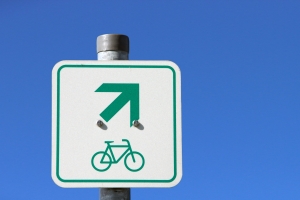- Increases in observed ridership within one year of protected bike lanes' construction ranged from +21% to +171%
- Increases appeared to be greater than overall increases in bicycle commuting in each city
- Increases were made up of 11% new riders, or riders who would not have traveled by bike without the protected lane, and 89% riders who took the route because of the new lane, but would have biked anyway
- 96% of interviewed cyclists felt that the protected lane increased the safety of bicycling on the street
- 79% of residents interviewed felt that the protected lane increased the safety of bicycling on the street
- 43% of people stated that protected bike lanes had made their neighborhoods a more desirable place to live, as opposed to 14% who believed it actually reduced desirability
- 19% of intercepted bicyclists said that they stopped at businesses along the protected bike lane more often than before its installation
- 53% of drivers in communities where protected bike lanes were installed stated that predictability of bicyclists had increased, as opposed to 12% who said it had decreased
- 14% of respondents said that they avoided roads with protected bike lanes installed
- 30-55% of residents stated that impacts to parking were negative; impact to parking was the study's most negative perception
Related Stories
| Dec 10, 2011
10 Great Solutions
The editors of Building Design+Construction present 10 “Great Solutions” that highlight innovative technology and products that can be used to address some of the many problems Building Teams face in their day-to-day work. Readers are encouraged to submit entries for Great Solutions; if we use yours, you’ll receive a $25 gift certificate. Look for more Great Solutions in 2012 at: www.bdcnetwork.com/greatsolutions/2012.
| Oct 17, 2011
Clery Act report reveals community colleges lacking integrated mass notification systems
“Detailed Analysis of U.S. College and University Annual Clery Act Reports” study now available.
| Sep 14, 2011
Research shows large gap in safety focus
82% of public, private and 2-year specialized colleges and universities believe they are not very effective at managing safe and secure openings or identities.
| Sep 12, 2011
Morgan Thermal Ceramics’ system for installing grease duct enclosures achieves UL listing
Updated installation results in 33% space savings.
| May 25, 2011
TOTO tests universal design at the AIA conference
If you could be 80 years old for 30 minutes—and have to readjust everything you think you know about your own mobility—would you do it?
| May 4, 2011
SAFTI FIRST to debut free apps for iPhone, iPod Touch, and iPad at AIA Convention
SAFTI FIRST, manufacturer of fire rated glass and framing solutions, will debut its mySAFTI app, the first interactive design tool that takes the guesswork out of choosing the correct fire rated glass product, at the AIA National Convention in New Orleans, May 12-14. Visit booth1634.
| Feb 11, 2011
Four Products That Stand Up to Hurricanes
What do a panelized wall system, a newly developed roof hatch, spray polyurethane foam, and a custom-made curtain wall have in common? They’ve been extensively researched and tested for their ability to take abuse from the likes of Hurricane Katrina.
| Oct 12, 2010
Cell and Genome Sciences Building, Farmington, Conn.
27th Annual Reconstruction Awards—Silver Award. Administrators at the University of Connecticut Health Center in Farmington didn’t think much of the 1970s building they planned to turn into the school’s Cell and Genome Sciences Building. It’s not that the former toxicology research facility was in such terrible shape, but the 117,800-sf structure had almost no windows and its interior was dark and chopped up.















